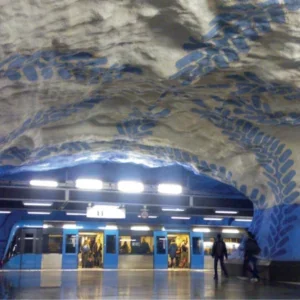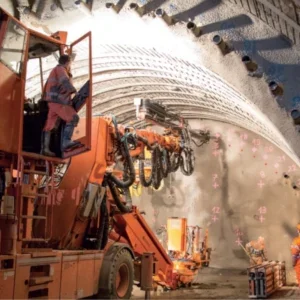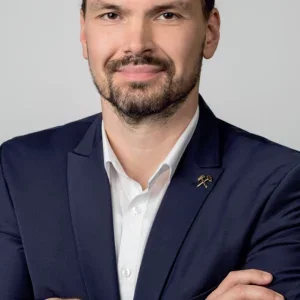A digital clock flicks to 8:00 at the front of a coach parked just outside of Oslo’s Central Station and the driver already has the bus in gear. Passengers are mostly quiet during the 20-minute ride to the Acciona Ghella Joint Venture (AGJV) worksite about 14km south of the city in an area called Asland.
The bus brings staff to work and back each morning and is one component of sustainability the JV is championing on this EPC project. On site there are barracks to accommodate up to 450 crew members who work two-weeks on and two-weeks off. A canteen serves a mix of Spanish, Italian and Norwegian comfort foods. The project proudly boasts there are 29 different nationalities represented among its workforce. The tunnel will be the most significant part of the project, including two 20km separate single-track twin tunnels. AGJV is constructing 18.5km of the tunnels on behalf of the client Bane NOR.
Further on a large warehouse encompass all the supplies, equipment and facilities to manufacture the precast segments to line the tunnels, which will be the longest for rail in Scandinavia.
Work is underway 24/6, with Sundays restricted by Norwegian employment regulations. While four TBMs mine the Follo Line this site serves almost as a small town, which the JV says is as sustainable as possible. The spoil has filled a reservoir to the south of the precast factory. The impact to local community has been minimal as far as trucking, noise and dust.
Many of these efforts can be dubbed sustainable but realistically and more significantly they cogs in a machine that enable the nearly simultaneous deployment of four 9.96m diameter double shield TBMs, from a single location to mine twin tunnels that are each 20km long. That is not mentioning what has been already highly promoted in this magazine and elsewhere – these are four TBMs mining the hard rock of Norway, which has been content with drill and blast for the many hundreds of kilometres of road and rail tunnels crossing the country.
Mining north to Oslo the first two TBMs made their breakthroughs on 11 September awaited by staff and media in a cavern illuminated by black lights and a light show. The JV says marking this accomplishment was incredibly important to show support and appreciation to both the crew and the client, Bane Nor.
In 2012 the client decided to do twin tubes using four TBMs, operating from a central location. TBMs had not been considered in Norway, says Bane Nor Follo Line project manager for the TBM, Anne Kathrine Kalager. “The statements have been that the rock is too hard; it’s so difficult to do pre-grouting and the excavated material has no value.
“But this project has demonstrated the opposite,” Kalager tells the audience at the TBM’s reception area on the day of the breakthrough.
She explains, “we used expertise from TBM hard rock tunnelling that took place in the past to make specifications for our machines and to tailor them for the geological conditions they will operate in. During the excavation we have seen that the machines have fulfilled our expectations and they worked as expected. Also through these extreme hard rock excavations they handled water in a sufficient way. And the excavated material is being used as a basement for a future development.”
The message she has for the international tunnelling industry is this: “neither the ground conditions nor the properties of the excavated materials should prevent us from excavating tunnels with TBMs in Norway.”
After the first two TBMs made their breakthroughs on September 11 T&T toured the worksite with AGJV. The JV has one of four EPC contracts for the entire project and is working with subcontractors MTC, Cowi, Norwegian AF Gruppen and Sweden’s Peab. This is for Acciona and Ghella the first contract in Norway. For detailed coverage of the project’s design and initial stages of construction.
On site
Framed by pine trees and neighbourhoods in the distance the worksite is relatively silent despite the nearby crews operating heavy machinery to move spoil, conveyors running in and out of the tunnel adits, and on-site precast manufacturing. There is a spoil management area, concrete plants, two water treatment plants and an entire ventilation system to suit a mine. Further on are workshops for maintenance, and all of these components are strategically located away from the barracks and offices on the other side of the site to reduce noise and other disruptions.
In addition to the significance of using four TBMs, mining in hard rock and the longer lengths of the drives, one of the most important components of the project is that everything takes place at one site. “This is a sustainable little city,” says Fernando Vara Ortiz de la Torre, AGJV’s project director. “Everything is controlled and covered from noise and dust, and from operational perspective it is really efficient.”
AGJV invested almost an entire year in designing the site and defining how various areas will function. There was also the need to anticipate operations during Norway’s harsh winter weather– covered conveyors once they leave the tunnels, heating the roads and other concerns.
A previous contract concerned the construction of a 1km adit tunnel done with drill and blast, approximately 150m underground and created caverns to access the two tunnels going north and the two going south. There are also a number of smaller rescue tunnels, done with drill and blast.
There are three precast factories and storage areas for the segments. For all four of the 9km-long TBM drives AGJV needs to manufacture 140,000 segments, starting with 2,500 segments in storage for the for TBMs. The JV has chosen to self-perform the manufacturing for multiple reasons mainly to control and monitor the quality as well as the benefits gained by reducing the need to transport segments to site.
The task requires half a million cubic metres of concrete and spoil is being reused for manufacturing the segments. Although that has changed from the initial plans, Fernando Vara explains. There was a component in the aggregates from the tunnels that could potentially have durability issues. AGJV discussed the situation with the client, Bane Nor, an agreement was achieved for using commercial aggregates to avoid even the smallest potential risks reusing the aggregates.
Conveyors for the four TBMs, supplied by Marti Technik, merge in the middle allowing AGJV to put all four TBMs on just one conveyor belt if necessary and for the JV to do maintenance. The capacity of the conveyors are 2,000t per hour. All the spoil goes to a large shed where it will be eventually sent to the three pre cast batching plants – everything completely covered for protection from rain and snow and preventing any weather disruptions. There is a spoil pit, which started empty at about 25m depth and is now completely full. A new residential area will be developed here once the project is complete and the worksite dismantled.
AGJV has 32 different molds for the Follo Line’s segments. Rings are 1.8m long and comprise six segments, plus the key and the diameters are 9.5m outside, and 8.75m inside. These are reinforced with steel and have Datwyler gaskets capable of withstanding 33 bar. Segments are in the oven for seven hours at 55C and 100 per cent humidity before being stored to reach their full strength. In the winter crews make use of a transition zone because the temperature can vary significantly–dropping as low as -20°C outside.
To bring the segments to the TBM the JV has chosen to use MSVs or multi-service vehicles to make the many kilometer journey to the face. Manufactured by TMS, the 50m-long trains have a load capacity of 125t and are very low allowing the gantries to lift the segments. They travel in both directions and can cope with a tight turning radius, Vara explains. “They’re very good for us with the logistics of our tunnels. At peak operations the JV used eight MSVs.
At the time of T&T’s visit one production line was in operation, which employs about 100 people, according to Line Fredriksen, community and stakeholder manager at AGJV. She explains the average production of segments during the project varied depending on the TBMs’ progress.
Crews are expected to finish manufacturing segments for the project in December, producing 1-2 per cent more than needed just in case.
Vara says, “the challenge of four TBMs from the same location at the same time was very, very hard to achieve but we’ve done it.”
Norway’s return to tbms
In anticipation of the hard rock and the length of the four tunnel drives AGJV gave a lot of consideration to the design of the double shield TBMs.
“This is a very hard rock,” Vara says, adding, “it’s very hard, about 300 MPa. There is some kind of mix face you’ll find, and there is not a big overburden–a maximum of 100-150m. And the ground water level is really in the surface.”
There are 71 cutter discs (19 inches), on each machine, with additional reinforcements to enlarge the cutterhead. Crews are changing 10-12 cutter discs per day.
“As well the main bearing was increased from its 6m size to 6.6m to confirm that there isn’t any potential for main beam failure. Because this is a long tunnel–we’ve have been mining in there for two years with such hard rock.”
Considering the success of the first two drives and the breakthroughs the day before, Vara says, it was a good decision to invest so much in the TBM.
“We’re very satisfied. The TBMs arrived spring 2016, and we started on the fifth of September 2016, almost two years ago. To do 9km in two years is very good knowing that we have been doing a lot of pre grouting, and we have changed a lot of cutter discs. We have achieved the expected average of 14-15 m a day, even with more pregrouting than expected.”
There are areas along the alignment with highly sensitive ground due to clay nearer the surface. The client had concerns about the potential for settlement and set in place a programme of mandatory pre grouting. Crews drill 40 holes in the face to detect the presence of water, which would require grout injections for 35m in advance of the TBM. “This has created production figures that do not seem spectacular compared to other TBM projects around the world” Fernando says. “But when you put them in the context of the pre grouting it really is amazing.”
In terms of the four TBMs he points out all they all have the essentially the same production maximums by daily, weekly, and monthly rates.
There are 40 cross passages for the project and a separate contractor is performing the work, which comprises drill and blast excavation with Peri formwork every 450m. The project uses an SMS warning system prior to blasting and Vara says the four to five blasts per day cause no interruptions to TBM mining. The entire site has been designed to avoid traffic jams and keep the TBMs moving.
Vara is proud of Acciona’s capability to design the logistics and work through the Norwegian weather conditions; to keep and be ahead of schedule despite the pre excavation grouting.
At the time of the breakthrough celebration the two southbound TBMs were approximately 2km from their final destination in Ski, with an estimated arrival in March 2019. The project is scheduled for completion in December 2021.
When the line is operational it will reduce travel time from 22 to 11 minutes, literally leading the way for future high speed rail to Stockholm.






